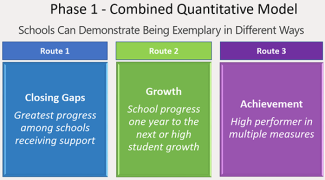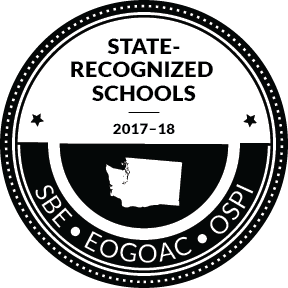June 2019 Announcement
- Schools who were unable to attend the June 6 celebration in Olympia or Spokane can pick up their banner at their local ESD.
Background on the New State School Recognition System
Approximately one year ago, the SBE, OSPI, and EOGOAC agreed to suspend school recognition for one year in order for a workgroup to be formed for the purpose of redesigning the school recognition system. The rationale to redesign the system was driven in part by the changes brought about by the shift to the Every Student Succeeds Act (ESSA) accountability system and by the desire of the organizations to make the school recognition system more equitable. The now outdated Washington Achievement Awards were based on measures, some of which are no longer computed, that tended to be highly correlated to the school Free and Reduced Price Lunch (FRL) rate. In the past, the state made 450 awards in seven categories to nearly 300 schools. Most awards went to schools with lower than average FRL rates in the Puget Sound region and many schools received multiple awards. The SBE, OSPI, and EOGOAC all agreed that a change was needed.
SBE, OSPI, and EOGOAC staff worked closely together in consultation with the recognition workgroup and each of our respective organizations to design a pilot recognition system as the first phase in the development of a new recognition framework for Washington that incorporates state level and local information to identify schools that are exemplars in terms of growth and achievement. Unlike prior recognition frameworks, this approach is designed to identify schools throughout the continuum of support. As such, this revised framework will recognize schools that have made gains in targeted areas and are on a path toward overall improvements in achievement and growth. The Framework describes a single system of recognition that incorporates three pathways to recognition, and multiple measures within each pathway.

First Phase of the New State School Recognition System (May 2019)
The use of multiple stages or paths and multiple measures provides schools with multiple ways in which to qualify for recognition. The approach is summarized as follows:

- Closing Gaps: recognizes schools previously identified for ESSA support tiers 1-3 with low performing student groups that showed substantial improvement.
- Growth: recognizes schools making the largest annual gains on the Washington School Improvement Framework (WSIF) measures and meeting the gap reduction requirement - the WSIF gap between the highest and lowest performing student group must be narrowing.
- Achievement: recognizes the highest achieving schools on ELA and math proficiency, high school graduation rate, and the School Quality and Student Success (SQSS) measures, and meeting the winter 2019 WSIF performance requirement – all student groups must be performing at 6.0 or higher on the 2019 WISF, well above the state average.
If you would like to view a more detailed description of the three routes to recognition or see more about the statewide results from the Phase I School Recognition Methodology, view our methodology page.
If you have questions about which specific metrics were used to identify your school for recognition, view this spreadsheet to learn more. If you have questions about the final methodology for phase one of the new school recognition system, you can review a more detailed description of the methodology. If you have questions about why your school was not identifed for recognition and you want to review your school's data, view this spreadsheet to learn more.
Results and School Identifications
The three approaches resulted in the recognition of 216 schools:
- Average enrollment is 429 students.
- Average FRL (Free and Reduced Price Lunch) rate is 40.1 percent, just a little lower than the average for all schools.
- Elementary schools = 137, middle schools = 34, high schools = 22, combined schools = 6, and combined high schools = 17.
- Approximately 54 percent of the recognized schools (117/216) were identified for Tier 1-3 supports in the winter 2018 WSIF.
- The distribution by ESD and across the state is fairly representative.
- The demography of the recognized schools is similar in many respects to the demography of schools not identified, but some smaller differences are apparent.
Social Media Toolkit
For districts that would like to post announcements on their social media, we have an image that can be used for Facebook or Twitter, along with headers formatted for Facebook and Twitter. You can download those images on the SBE Google Drive.
State Recognized Schools for 2017-2018
Please note: Schools who were unable to attend the June 6 celebration can pick up their banners at their local ESD.

